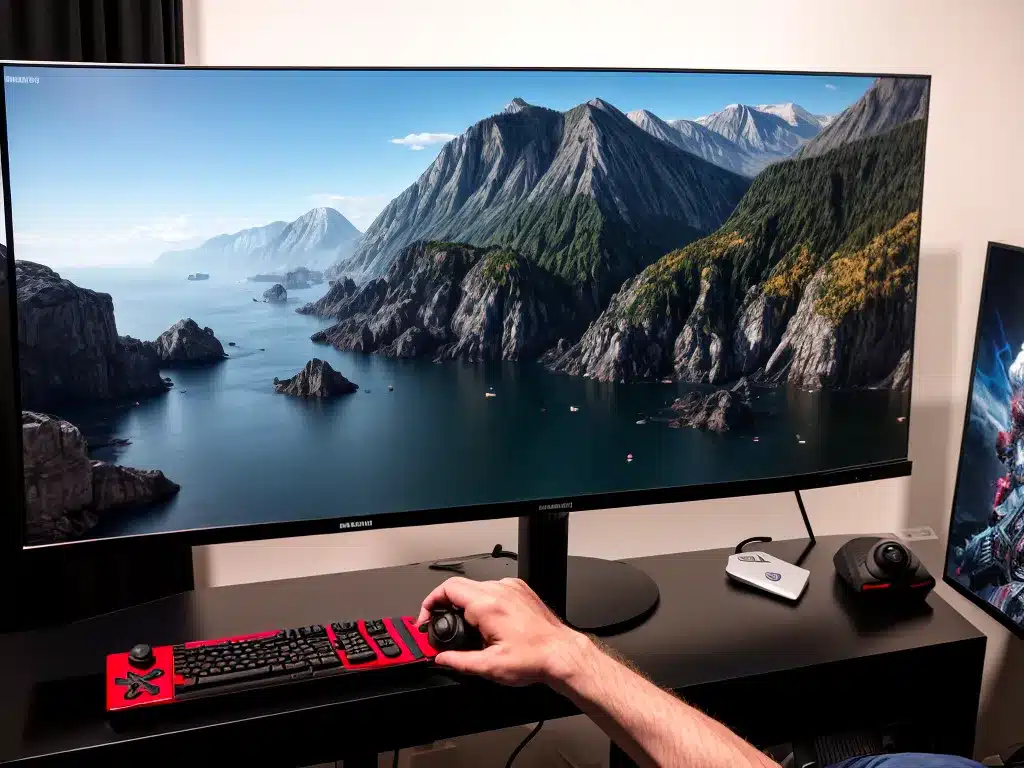
Introduction
I recently had the opportunity to test out some of the latest 8K gaming monitors hitting the market. 8K represents the next big leap in display resolution, 4 times the pixel count of 4K displays. These cutting-edge monitors promise incredibly sharp and detailed visuals for gaming and media consumption. However, 8K comes with some unique challenges and requirements. In this hands-on review, I’ll discuss my experiences using these monitors for gaming and evaluate if 8K is worth it for most gamers currently.
Key Features of 8K Gaming Monitors
Some of the key features and specs of the latest 8K gaming monitors include:
-
Resolution – 8K monitors have a resolution of 7680 x 4320 pixels, 4 times more pixels than 4K resolution of 3840 x 2160. This allows for unbelievable clarity and detail.
-
Screen Size – Current 8K gaming monitors range from 27″ to 32″ in size. The extra resolution is especially useful on larger screen sizes.
-
Refresh Rate – Many 8K models support refresh rates of 60Hz, 120Hz or even 144Hz. Higher refresh rates result in smoother motion clarity for gaming.
-
Response Time – 8K gaming monitors need fast response times, often 1-4ms, to prevent ghosting or motion blur.
-
HDR – High dynamic range is common on 8K monitors to produce vivid colors and enhanced contrast. Popular standards include HDR10 and Dolby Vision.
-
Connectivity – To handle 8K resolution, monitors need HDMI 2.1 or DisplayPort 1.4 connectivity capable of high bandwidth.
Gaming Performance and Experience
Gaming in 8K resolution is an incredible visual experience. With 4 times as many pixels as 4K, the added resolution makes games breathtakingly sharp and detailed. Everything from textures to lighting to small details are enhanced. It really feels like a big jump up from 4K.
However, to fully take advantage of 8K resolution for gaming, there are some important requirements:
-
Graphics Card – You need a very powerful modern GPU like an RTX 3090 or Radeon RX 6900 XT capable of 8K output. Even these struggle to hit high frame rates at 8K in modern games.
-
Optimized Games – Games need to be well optimized and support 8K resolution. Many modern games like Microsoft Flight Simulator or Cyberpunk 2077 deliver a stunning 8K presentation. But many older titles do not scale well.
-
Framerates – Don’t expect high framerates above 60 FPS in most modern triple-A games. To run 8K smoothly you’ll need to balance graphical settings. Competition esports gamers may find the lower frame rates compared to 1080p or 1440p displays to be a disadvantage.
Overall, while 8K gaming is impressive, the technical demands mean it’s not always practical. 4K at high frame rates still offers a great experience for most gamers. But for those wanting the best and most future-proof, 8K provides an incredible level of fidelity.
Physical Setup and Usage Notes
Using an 8K display for gaming and general use comes with some unique considerations:
-
Viewing Distance – To fully perceive 8K resolution, you need to sit fairly close to the display, generally 1-1.5m or less. If you sit further away, you won’t get the full benefit.
-
Desk Space – The monitor takes up a large footprint on your desk. Make sure you have enough depth and clearance to accommodate a 30″+ monitor.
-
Cabling – You need HDMI 2.1 or DisplayPort 1.4 cables to connect at 8K 60Hz. Make sure your graphics card and monitor both support these specifications. Older cables won’t work.
-
Power Consumption – Driving 8K resolution requires more graphics power, so expect higher energy usage especially under load. Cooling requirements are also increased.
-
Text Scaling – Default text and UI elements can appear very small at native 8K resolution. You may need to scale up text and icons for comfortable usage.
Is It Worth Buying Now?
For most average gamers, I think 4K 144Hz or ultrawide 1440p monitors are still the sweet spot right now. They offer great balance of visual fidelity and high frame rates.
However, if you want the absolute best quality and most future-proof display, 8K gaming monitors do deliver a stunning next-gen experience. The ability to game and watch movies at such high resolution brings desktop visuals to new heights. Just be prepared to invest in top-end GPU power as well.
Within the next 2-3 years, I expect adoption to pick up as graphics cards get more capable of 8K rendering. For now, the extra costs and setup considerations make 8K mainly for early adopters. But the future is certainly 8K for high-end gaming.
Summary
In summary here are my key takeaways after testing the latest 8K gaming monitors:
- Stunning levels of detail and fidelity, a big upgrade from 4K
- Require top-tier GPU power for smooth frame rates
- Work best for slower paced, visual focused gaming
- Require ideal viewing distance and desktop space
- Extra costs and setup considerations required
- Best suited for enthusiast early adopters currently
- Amazing future-proof display technology as GPUs catch up
While not entirely practical or affordable yet for most, 8K gaming monitors offer an exciting glimpse into the future of display technology. The visual jump to 8K resolution is impressive and immersive. For those seeking the ultimate gaming experience, 8K delivers incredible clarity and detail.












